Dr. Shilpi Bhadra Mehta is a Doctor of Optometry, a Board Member of the Archaeological Institute of America, and leader of the Boston Paleo group, Living Paleo in Boston. I asked her to tell us about Indian cuisine, and she offered a discussion of Bengali Fish Curry. We’re doing it in two parts: first, a discussion of its health benefits; second, a recipe with pictures. — Paul
This recipe for Bengali Fish Curry provides 6-8 servings. It will be good up to 5 days in the fridge after cooking. Keep the skin on the fish if it’s wild!
Ingredients
2 pounds fillet or steak of wild fish with skin-in (preferably a high Omega 3 fish like salmon)
1 Large Onion, diced or sliced
3 Tablespoons Ginger Paste (Don’t use if taking warfarin, blood thinners, or have gallstones)
2 Teaspoons Kalo Jeera/Kalonji/Nigella Seeds (available in South Asian grocery stores)
Macadamia Nut Oil
Turmeric powder
Juice of Half a Lemon or 1 Small Lime
1 Cup chopped fresh Cilantro
1 Teaspoon Sea Salt (more can be added to taste by the individual)
Optional:
2 medium Vine Ripe Tomatoes, chopped
1 Green Chili Pepper
1 Teaspoon Red Chili Powder/Cayenne /(Paprika for less heat)
Preparation:
Sprinkle turmeric and salt lightly over both sides of the fish (but not the side with skin if your fish has it). Squeeze the juice of half a lemon/lime on the fish (but not the side with skin if your fish has it). Let it marinate on the counter for 15 minutes, or longer in the fridge for up to 2 days.
Sautéing the Fish:
1) Heat oil in a pan at medium to medium-high heat (depending on your stove). The oil should be sizzling but not smoking. If oil is too cool or the pan gets dry then the fish might break or stick to the pan. Slide fish pieces carefully into hot oil, in a single layer placing them flat.
2) Sauté fish about 2 min to a light brown on each side and flip only once. Do not fry to a dark brown, or they can become stiff and chewy. Then set the fish pieces on a plate.
Making the Sauce/Curry:
1) Heat the remaining oil in the pan to the same temperature as before. Add more oil if necessary – do not let your pan get dry or the fish will stick! Add the Nigella/Kalonji seeds.
2) When the seeds sizzle, add the onion in and fry for 2 – 3 minutes till they get translucent.
3) Stir in the chili, tomato and the ginger, and continue to cook about another 3-5 minutes till the tomatoes become soft and start to break up.
4) Pour in about 2 cups water, and return fish to pan and place them in a single layer, with the skin surface touching the pan. Add fresh cilantro, cover the pan, turn down heat and let simmer for about 10-15 minutes until fish is cooked, and then turn off heat.
5) Enjoy with rice cooked in butter or ghee (you can top with ghee or butter, too) and a vegetable of choice (in this case it was bok choy) for a Perfect Health meal!







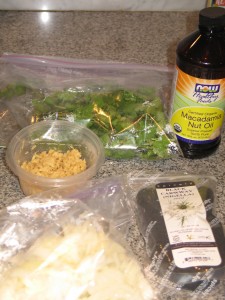
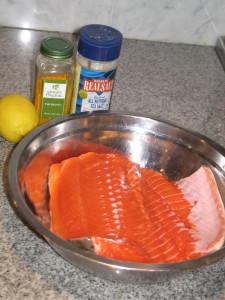
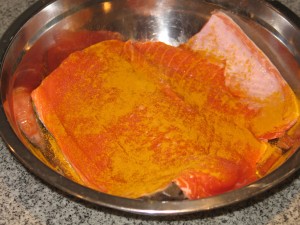
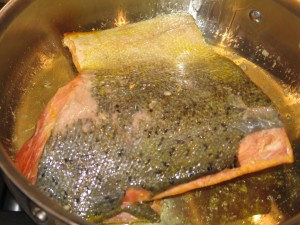
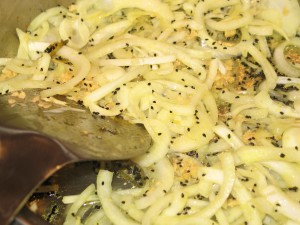
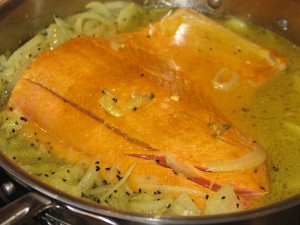
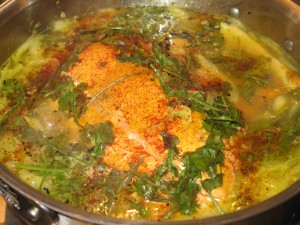
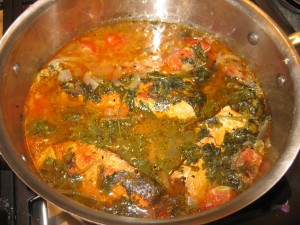
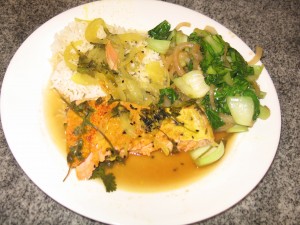




Man does that look delicious!
Supberb! I’m a lot more familiar with north Indian, but really do need to explore these simple, flavoursome and nutritious south Indian dishes.
just wanted to give a shout out for Bengali pride 🙂
I need to learn how to cook and then paleofy my mum’s lamb curry
This looks fantastic but I can’t get those seeds in Tokyo, what would be a good alternative? Would mustard seeds work? Thank you!
Hi Wati,
Nigella can be known as kalonji or mislabeled as black seeds, black onion seeds, black caraway. I have only tried black sesame and black mustard seeds.
Several websites give these options:
1) celery seeds
2) black sesame seeds
3) black mustard seeds
http://www.ehow.com/list_6885777_substitutes-nigella-seeds.html
http://chowhound.chow.com/topics/283679
Happy cooking!
That looks great! I’m one of those people who don’t like fish… I just don’t like the taste. The only fish I like is Mahi-Mahi if it’s fresh.
But I like curries and this just might be the solution for me to include more fish in my diet.
Thank you Paul, Shou-Ching and Dr. Mehta!
Looks tasty!
One question for Paul if I could ask: What are your thoughts on modifying the perfecthealthdiet to be an ovo-pescatarian diet. I am only going to be eating fish/seafood and eggs for my animal food intake, no meats or dairy of any kind. What additional supplements if any would be necessary for those things that I might not be getting by avoiding meats and dairy? Thanks!
Hi Haig,
I don’t think you lose much. I would recommend including clarified butter as a source of healthy fats. The main loss would be in minerals from lack of bone broth or liver; maybe some extra minerals.
But do eat plenty of seafood and eggs.
Thanks for the quick response!
I’m mainly concerned over the lack of carnitine and creatine which is mostly found in red meat and not much else, perhaps I should supplement?
Hi haig,
Well, it wouldn’t do any harm to supplement those, but I’m not sure it’s necessary. Both are present in fish.
ginger is bad for gall stone? this is new to me.
regards,
Dr Mehta,
Thanks for this recipe. I intend to try it soon. The one aspect of the PHD I have not done well at is eating my pound of fish a week. I don’t mind fish; I just tend to destroy it when I cook. I’m not familiar with ginger paste. Is that a product or just ground up fresh ginger?
Hi Kate,
Here are some tips for the fish – I used to destroy it too! You need to minimize moving the fish pieces or they will break apart. Try to use larger pieces – but not so large that you cannot maneuver them. The oil needs to hot enough to sizzle but not smoke so the fish doesn’t stick. You may have to add more oil as needed – you don’t want the pan going dry or again the fish will stick.
I make my own ginger paste- just ground up fresh ginger as you mentioned.
A pound of fish would be 4 portions of 4 oz. fish. That would be eating about 4 servings of fish a week, or if you want a smaller portion go to 5 servings.
Best,
In your recipes, there is mostly white rice. What about the other safe starches you recommend? Or is white rice the best safe starch?
Thx
Jasmin
Hi JP,
No, it’s not the best, but it’s the one you’ll see meat/fish entrees on top of most often. We use potatoes in long-cooking stews and soups and as a side portion with butter or sour cream; we don’t often serve an entree over potatoes. Although there would be nothing wrong with that.
Hi JP,
Traditionally Bengalis will often add potato to vegetable, meat, and fish recipes – you could slice up potatoes thin and small so they will cook while the fish is simmering. Or you could boil or steam then separately and then add them so they absorb the fish curry spices.
I love this recipe and tried it a few times. However now that I am pregnant should I be concerned about eating the black seeds/nigella?
Apparently it can induce contrations and is not recommended in pregnancy.
Dr Mehta mentions not to take flax seed in pregnancy but I wondered why black seed was not mentioned?
Thanks
Hi Claire,
Hmm. I’m not sure. Nigella can act as a contraceptive (http://www.ncbi.nlm.nih.gov/pubmed/7705872) and this paper says it may do it by inhibiting (not inducing) contractions: http://www.ncbi.nlm.nih.gov/pubmed/8733115. But it promotes milk production: http://www.ncbi.nlm.nih.gov/pubmed/5167246, http://www.ncbi.nlm.nih.gov/pubmed/23433051. And this paper says nigella is beneficial for the embryos of diabetic mothers: http://www.ncbi.nlm.nih.gov/pubmed/19090108.
We actually haven’t used nigella seeds yet, we’ve used caraway seeds instead. There’s even less data on them.
I would say there’s little reason to be concerned as long as the dose is small. Diversify your seeds if you make this dish a lot, to keep the dose of each down.
Best, Paul